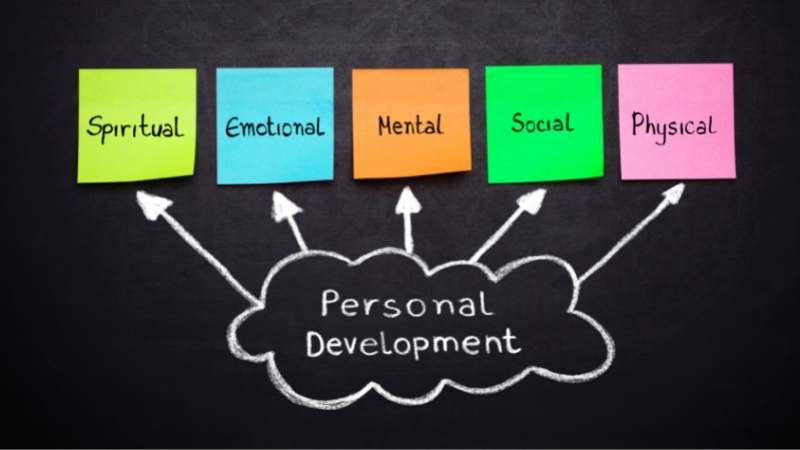Effective personal development strategies can help you get what you want. Personal development is the process of becoming your damndest best. Make yourself a priority to multiply your value and help others.
Personal development is the most practical way to start your journey to becoming an effective leader, a better parent, and a valuable citizen of the world.
People who invest time, effort, and money in personal development embrace a growth mindset. They have dreams and aspirations. They live their principles and values. They act on purpose.
It isn’t like eating an elephant in one meal. There are proven and practical ways you can do every day for half the effort and twice the results.
Personal development is not about reaching your highest potential. There are no boxes that mold you and me. Instead, it is about evolution. You have the power to create limitless possibilities.
Personal development begins with you.
It begins with you. But it is not all about you.
Keep this in mind so you will see what I am trying to say. The good thing about being Filipino is that we always consider our community.
Our actions benefit others. It is better to consider personal development as an act to be of service to others too.

Think different.
You can transform your life by pursuing personal development. It is not as difficult as most people imagine.
65-year-old Zig Ziglar told us that personal development is a lifelong pursuit. He said that he has his 10-year personal development plan.
16-year-old Jazz wants to start early to be the person she wants to be. She does not believe that someone needs to be ready to get started. To be prepared is to start when you are not yet an expert.
Age doesn’t matter. What matters is that you decide to keep on growing and become your damnedest best.
God has given you the gifts to be the master of your fate and the captain of your soul. I took this line from I Am the Master of My Fate.

Or explore the posts about personal growth.
Get training.
Many training providers pay more attention to career development and personality development. Many managers assumed that everyone is paying attention to self-growth.
But if we were to conduct a survey today, we’ll be in for a surprise. Many Filipinos do not set personal goals.
Everyone has dreams and new year’s resolutions, but it is seldom done I meet someone with personal goals.
Some experts teach visioning exercises. These exercises are helpful. However, they often fail to show people how to translate dreams into actions.
Every time I design a supervisory training course, I recommend a module on personal development. Not every manager will pay for that module, but those who care for accelerated growth and high performance willingly invest.
Importance of Personal Development Strategies
Personal development strategies are a set of practices, techniques, and habits that help individuals improve their skills, knowledge, productivity, performance, and overall quality of life.
These strategies often include setting personal goals, seeking feedback, continuous learning, reflecting on one’s experiences, and developing new habits or skills.
Leaders, in particular, need personal development strategies for many reasons.

Self-awareness: Personal development helps leaders understand their strengths and weaknesses, their motivations, and their emotional responses.
Skill Enhancement: Leaders need to constantly update and refine their skills to keep pace with rapidly changing business environments. This can range from technical skills to soft skills like communication, negotiation, or conflict resolution.
Improved Decision-Making: Understanding oneself better and learning new skills can significantly enhance a leader’s ability to make effective and informed decisions.
Adaptability: As leaders grow and develop personally, they become more adaptable and able to navigate change – an essential skill in today’s volatile business landscape.
Resilience: Personal development strategies often involve building emotional intelligence and resilience, which is critical for leaders to handle stress, setbacks, and challenges.
Effective Communication: Leaders who invest in personal development often become more effective communicators, capable of articulating their ideas more clearly and inspiring their teams.
Vision and Strategy Formation: Personal development can help leaders refine their vision and their ability to create and implement effective strategies, leading to better business outcomes.
People Development: By investing in their own development, leaders are better equipped to support the development of their team members. They can mentor others more effectively and foster a culture of continuous learning and growth.
Improved Productivity: Personal development strategies often lead to improved productivity as leaders learn to manage their time effectively, prioritize tasks, and focus on what’s important.
Job Satisfaction and Employee Retention: Leaders who continuously develop tend to be more satisfied in their roles, and this has a positive impact on the people they lead. They can create a positive work environment that can improve employee retention.
Personal development strategies not only help leaders improve their personal and professional lives, but they also have a profound impact on the people they lead and the organizations they work for.
10 Personal Development Strategies
1. Coaching and Mentoring
Coaching and mentoring are powerful strategies that leaders can use to foster personal development in their teams.
Provide one-on-one guidance to team members to help them build on their strengths, work on their weaknesses, and achieve their professional goals.
It provides personalized support and direction based on each individual’s unique needs.
Advantages:
- It accelerates skill development by providing direct, actionable feedback.
- It helps individuals feel more supported and valued, which can boost their motivation and engagement.
- It allows leaders to share their expertise and experience, helping team members avoid potential pitfalls and reach their potential more quickly.
And how can you implement a mentoring program?
Implementing a coaching and mentoring program starts with selecting suitable mentors and coaches. They should be experienced, knowledgeable, and have good interpersonal skills.
Next, it’s essential to establish clear expectations for both the coach/mentor and the individual. This might involve setting specific goals, defining the frequency of meetings, and discussing the areas of focus.
Finally, it’s important to maintain open lines of communication and provide ongoing support to ensure the coaching or mentoring relationship is effective and beneficial for all parties.
2. Empowerment
Empowerment is about giving team members the autonomy to make decisions and take responsibility for their work.
Encourage individuals to take initiative and gives them the confidence to solve problems independently.
Advantages:
- It can lead to more creative solutions as people feel free to think outside the box.
- It also improves job satisfaction, as team members feel more engaged and valued.
- It can improve efficiency, as decisions can be made more quickly without needing approval from higher-ups every time.
Start with creating a supportive environment where people feel safe taking risks.
Define the boundaries of decision-making authority for each team member, to avoid confusion or conflict.
Regular feedback is also crucial, both to guide individuals and to reassure them that they’re on the right track.
Celebrate successes and learn from mistakes.
3. Provide Constructive Feedback
Providing constructive feedback is a critical strategy for helping individuals learn and grow.
Feedback gives team members insight into their performance, helping them understand where they excel and where there’s room for improvement.
Advantages:
- It promotes self-awareness, allows for continuous improvement, and helps individuals align their performance with the team’s and organization’s goals.
- When done correctly, it can strengthen the relationship between leaders and team members, fostering open communication and trust.
Create a culture of openness and respect where feedback is welcomed and valued. Feedback should be specific, timely, and focused on behaviors and performance rather than personal characteristics.
Provide positive feedback as well as corrective feedback.
Encourage two-way feedback – not only should leaders provide feedback to team members, but they should also be open to receiving feedback from them.
4. Encourage Continuous Learning
Foster a culture where ongoing education and skill development are valued and rewarded.
Encourage team members to attend workshops or conferences, offer in-house training, or support further education.
The benefits of continuous learning are significant.
- It helps keep skills and knowledge up to date, which is particularly important in fast-changing fields.
- It boosts confidence and job satisfaction, as individuals feel they’re growing and developing in their roles.
- It can lead to better performance and productivity as people become more proficient in their work.
Implementing a culture of continuous learning involves several steps.
Discuss with each team member their learning needs and interests.
Consider a variety of learning methods – not everyone learns best in the same way. Some may prefer hands-on training, while others may thrive with online courses or reading.
Provide the necessary resources and support, whether it’s time off to attend training, financial support for courses, or simply providing learning materials.
Recognize and reward learning achievements to reinforce the importance of continuous learning.
It’s also beneficial to share learning experiences within the team, as this encourages peer learning and helps create a community of learners.
5. Set Clear Expectations and Goals
Setting clear expectations and goals is about defining what success looks like for each team member and the team as a whole. These goals should be aligned with the team’s objectives and the overall strategy of the organization.
Advantages:
- They provide a roadmap for success, help individuals prioritize their work, and create a shared understanding of what needs to be accomplished.
- They also serve as a benchmark for performance reviews and feedback.
To implement this strategy, use the SMART framework to set goals that are Specific, Measurable, Achievable, Relevant, and Time-bound.
Regularly review these goals and adjust them as necessary.
Make sure each team member understands their goals and how they contribute to the team’s and the organization’s objectives.
And most importantly, ensure there is a system in place for tracking progress and celebrating achievements when goals are met.
6. Model the Behavior You Want to See
Modeling behavior is about leading by example. Leaders should exhibit the behaviors, attitudes, and values they wish to see in their team. This strategy is based on the understanding that people often learn and adopt behaviors they observe in others.
The benefits of this strategy include creating a positive work culture, promoting desirable behaviors, and building trust within the team. It also helps leaders gain respect and credibility from their team members.
To implement this strategy, leaders need to first identify the behaviors and attitudes they want to promote. Then, they should strive to consistently exhibit these behaviors in their interactions with team members and others.
Leaders should also openly acknowledge when they make mistakes and demonstrate how to learn from them.
Lastly, it’s important to provide positive reinforcement when team members exhibit the desired behaviors.
7. Foster a Positive Environment
Fostering a positive environment is about creating a workplace where people feel respected, valued, and comfortable. This includes promoting open communication, collaboration, respect, and fairness.
The advantages of a positive environment are significant. It can boost morale, increase productivity, reduce stress, and improve job satisfaction. It also helps attract and retain top talent.
Creating a positive environment starts with the leader. Leaders should treat all team members with respect, value their contributions, and promote positive communication.
They should also encourage team-building activities to strengthen relationships among team members. In addition, it’s important to deal with conflicts and issues promptly and fairly.
Finally, leaders should recognize and celebrate team achievements to boost morale and reinforce positivity.
8. Promote Work-Life Balance
Promoting work-life balance involves encouraging team members to maintain a healthy balance between their work commitments and their personal lives. This could mean offering flexible working arrangements, limiting after-hours work, or simply encouraging regular breaks during the workday.
The benefits of work-life balance are many. It can reduce stress, improve mental health, and increase job satisfaction. It can also improve productivity and reduce employee turnover.
Promoting work-life balance requires recognizing that each team member has personal commitments and responsibilities outside of work.
Offering flexible working hours, remote work options, or job-sharing can help. Encourage team members to take regular breaks and use their vacation time.
Lastly, leaders should model good work-life balance themselves to show that it’s valued within the organization.
9. Recognize and Reward
Recognizing and rewarding effort and achievement is about acknowledging good performance and showing appreciation. Rewards can be tangible
like bonuses or promotions, or intangible like praise or increased responsibilities.
The advantages of recognizing and rewarding are substantial. It can increase motivation, boost morale, and improve job satisfaction. It also encourages the repetition of desirable behaviors and enhances loyalty to the organization.
Implementing recognition and reward starts with identifying the behaviors and achievements that should be rewarded.
Then, establish a system for recognition. This could be formal, like a monthly award ceremony, or informal, like a spontaneous word of praise. Ensure the rewards are meaningful to the individuals.
For some, public recognition might be motivating, while others might prefer private praise or a physical reward.
Lastly, be consistent and fair with your recognition and rewards to maintain their effectiveness.
10. Encourage Networking
Encouraging networking is about promoting relationships both within and outside the organization. Networking can lead to new opportunities for learning, collaboration, and career development.
The advantages of networking are numerous. It can open up new opportunities, increase the exchange of ideas, and enhance career progression. It can also lead to collaborations that benefit the individual and the organization.
Implementing networking as a strategy involves creating opportunities for team members to interact with others. This could be through team-building activities, attending conferences, or encouraging participation in professional organizations.
Leaders can also introduce their team members to their own professional contacts.
Lastly, fostering a culture that values collaboration and open communication can naturally encourage networking.

